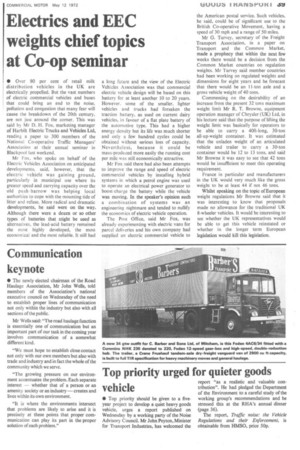Electrics and EEC weights chief topics at Co-op seminar
Page 41

If you've noticed an error in this article please click here to report it so we can fix it.
• Over 80 per cent of retail milk distribution vehicles in the UK are electrically propelled. But the vast numbers of electric commercial vehicles and buses that could bring an end to the noise, pollution and congestion that many fear will cause the breakdown of the 20th century, are not just around the corner. This was said by Mr D. H. Fox, marketing manager of Harbilt Electric Trucks and Vehicles Ltd, reading a paper to 300 members of the National Co-operative Traffic Managers' Association at their annual seminar in Blackpool last weekend.
Mr Fox, who spoke on behalf of the Electric Vehicles Association on anticipated developments, said, however, that the electric vehicle was gaining ground, particularly in municipal use where its greater speed and carrying capacity over the old push-barrow was helping local authorities to cope with the mounting tide of litter and refuse. More radical and dramatic developments, he said were on the way. Although there were a dozen or so other types of batteries that might be used as alternatives, the lead-acid battery remained the most highly developed, the most economical and the most reliable. It still had
a long future and the view of the Electric Vehicles Association was that commercial electric vehicle design will be based on this battery for at least another 10 to 20 years. However, some of the smaller, lighter vehicles and trucks had forsaken the traction battery, as used on current dairy vehicles, in favour of a flat plate battery of the automotive type. This had a higher energy density but its life was much shorter and only a few hundred cycles could be obtained without serious loss of capacity. Nevertheless, because it could be mass-produced more easily the running cost per mile was still economically attractive.
Mr Fox said there had also been attempts to improve the range and speed of electric commercial vehicles by installing hybrid systems in which a petrol engine was used to operate an electrical power generator to boost-charge the battery while the vehicle was moving. In the speaker's opinion such a combination of systems was an engineering nightmare and tended to nullify the economics of electric vehicle operation.
The Post Office, said Mr Fox, was already experimenting with electric vans for parcel deliveries and his own company had supplied an electric commercial vehicle to
the American postal service. Such vehicles, he said, could be of significant use to the British Co-operative Movement, having a speed of 30 mph and a range of 50 miles.
Mr G. Turvey, secretary of the Freight Transport Association, in a paper on Transport and the Common Market, made a prophecy that within the next few weeks there would be a decision from the Common Market countries on regulation weights. Mr Turvey said member countries had been working on regulated weights and dimensions for eight years and he forecast that there would be an 11-ton axle and a gross vehicle weight of 40 tons.
Commenting on the desirability of an increase from the present 32 tons maximum weight limit Mr R. T. Browne, equipment operation manager of Chrysler (UK) Ltd, in his lecture said that the purpose of lifting the weight limit was basically for operators to be able to carry a 40ft-long, 30-ton all-up-weight container. It was estimated that the unladen weight of an articulated vehicle and trailer to carry a 30-ton container would be 12 to 13 tons, and said Mr Browne it was easy to see that 42 tons would be insufficient to meet this operating requirement.
France in particular and manufacturers in the UK would very much like the gross weight to be at least 44 if not 46 tons.
Whilst speaking on the topic of European weight regulations Mr Browne said that it was interesting to know that proposals made no allowance for the traditional UK 8-wheeler vehicles. It would be interesting to see whether the UK representatives would be able to get this vehicle reinstated or whether in the longer term European legislation would kill this legislation.
















































































































































































































